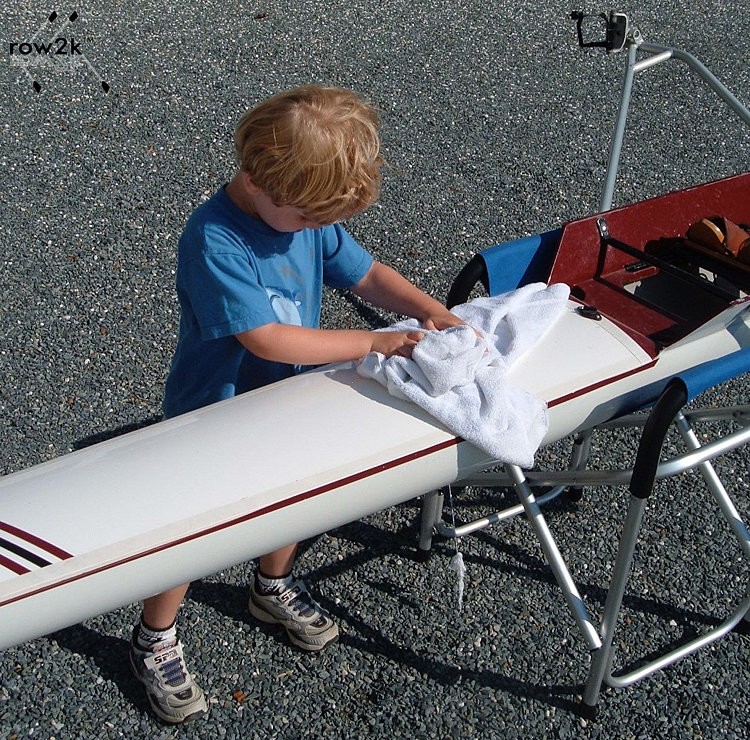Mike Davenport, MaxRigging.com

Following is another excerpt from Mike Davenport's posts designed to help rowing folks make the most of this downtime in the sport, as well as keep their programs on the water at any time; read the full article at Rowing Shell Preparation: A simple roadmap to get your shell ready to row.
It was a blazing-hot Florida day. I was busy, elbow-deep in boat work.
I had to leave a boat outside in slings - in the sun.
That boat, named after the President of our University, "Jerome P. Keuper," was a single-skin fiberglass eight. It was older but still in decent shape.
Around mid-day, with the sun at full strength, the fiberglass of the Keuper's hull gave way. The heat and years of sunlight caused the fiberglass in the boat to give up its strength and turn-to-mush.
The part of the shell sitting on the slings caved in and the boat crashed to the ground. The Keuper was a total loss. The best part of my day was informing my boss and the President of the school that I'd destroyed his boat. That was fun.
Since then I've always visualized a shell as a living thing with the thought that if I care for it, feed it, love it, then it will take care of me. Sure…it's hippy-thinking, but I've worked with hundreds-and-hundreds of shells over the years and that thinking has always served me well.
A shell needs to be prepared
Imagine you've been on vacation for an extended period…when it's time to go back to work it is a significant shift. You've got to get ready for a new routine. New workflows. New actions.
The same for a shell.
Following is a roadmap I use before each season to get shells ready to row. I found it increased the chance that a shell will be ready. Additionally, there were a few side-benefits such as:
-Increasing the life of the shell
-Reducing injuries
-Saving money
-Having more productive practices
-Missing less water time
That's a lot of benefits! Following is the roadmap, and it starts with dividing a shell up into areas that I call Zones.
Five specific Zones to help you fine tune your rowing shell preparation
To make things easier to get things done I divide a shell into five Zones. I put my focus on each Zone and try to work only in that Zone until it's done, and then I'll move onto the next Zone. This helps me focus and conserve time and resources. Each Zone has several actions to take.
To be clear, these actions are NOT about making rigging adjustments and fine tuning for speed. Instead, they ARE about getting the equipment READY for those adjustments. The work BEFORE the work, if you will. The assignments before the exam.
Off we go to greatness...
Zone 1: The Hull (inside & outside)
Action 1: Clean the hull. Cleaning it by hand can give you a feel of dings, dents or worse.
Action 2: Fix dents and holes. When cleaning, did you find dings/dents/holes? This is the best time to fix them. Putting SMALL repairs off often means that they won't get done until they turn into BIG repairs.
Action 3: Check and repair any superstructure issues. Turn the boat seats-up and check the insides.
Action 4: Bowball and bow number holder. This is a perfect time to make sure the bowball is safe (meaning it is in good shape and attached securely) and the clip for the bow number is also securely attached.
Zone 2: The Seats
Seats are critical for function AND for comfort. Don't cut corners with seats.
Action 5: Clean and in right place. Remove each seat and give each a cleaning. Double check for magnets for the electronic sensors.
Action 6: Condition of wheels. If yours show signs of wear, such as cracks, breaks or reduced size, replace with new ones.
Action 7: Condition of tracks. Tracks, like seat wheels, wear and need replacement, and new tracks often improve the feeling of rowing. I've found it best to replace both tracks in a position at the same time, but if your budget is tight replacing one at a time will probably work.

Action 8: Condition of seat top. This is a critical comfort area for every rower.
Zone 3: The Foot stretchers
Action 9: Correct sizes. Are the sizes of the shoes correct (or even in the ball park) for the rowers? The closer the size to the rower's foot the better the rowing. And YES I know…many of you are in situations where different people will be cycling through the seats, and that makes sneaker sizing a crazy time. But do the best you can to get the right size for the rower. Adjust as needed (both sneaker and rower)

Action 10: Condition of sneakers. Sneakers rip, they tear, they disintegrate into dust. A new set of sneakers, like the tracks we just discussed, can do wonders to improve rowing.
Action 11: Condition of fasteners. Check all fasteners for the sneakers and the foot stretcher. Tighten loose ones and replace bad ones.
Action 12: Heel ties/attachments. Heel ties will come loose, disintegrate, disappear. This step is not just about keeping referees happy at the racing launch dock. This is about keeping your rowers safe.
Having been in more than one capsized boat I can tell you that being able to get your feet OUT of the sneakers is something you want to work every time. 100%. Without failure.

Zone 4: The Riggers
Action 13: In right place? Simple question, do you know that each of your riggers are attached to the correct position in your boat?
Action 14: Condition of rigger frame. Check the rigger's frame for issues such as cracks (especially at welds), bent stays, missing or broken fasteners. Repair and replace as needed.
Action 15: Correctly tight. After confirming riggers are placed correctly and are in good shape, tighten them correctly. Here's a suggestion.
Action 16: Clean the oarlock. Clean the entire thing, especially where the oar rests. They get yucky…unbelievable so. (I actually found someone’s gum stuck on an oarlock. Why?). While cleaning, check for wear.
Zone 5: The Steering
Without good steering there is no telling where the boat will end up. So, is your steering working?
Action 17: How are the cables? Steering cables will wear; look at the cables, especially near any friction areas.
Action 18: Correct fin? With some makes of boats you can have different rudders for different seasons. If yours is adjustable, do you have the correct one on the boat?
Action 19: Coxswain seat. The coxswain seat usually only gets attention from the coxswain. They work hard - do them a solid and make sure where they sit and work is comfortable, safe, and functional.
Are the holders for electronics conveniently placed and solidly attached? A coxswain holding a SpeedCoach in one hand only has one hand to steer with.
Action 20: Toe good? If the boat is toe-steered, how are the connections and cables?
Action 21: Fin straight, rudder solid? Some steering issues are not due to human error but actually to misaligned fins or broken rudders. Are they both in good working order?
Wrap-up
There are 21 Actions you can take. Some quick-and-easy, some not, but all designed to help you get your shell ready for the season. As Dick Pereli says, "You want turn the necessity of maintenance into the habit/routine of maintenance."
After you complete these actions and have confidence your shell is ready it will be time to start rigging—making the adjustments for performance and speed. Here and here are a few resources to help you get there.
If you enjoy learning about equipment, check out Mike's course Basic Sweep Rigging. It's perfect for beginners who would love to increase their knowledge about rigging and other things about rowing equipment.
If you enjoy and rely on row2k, we need your help to be able to keep doing all this. Though row2k sometimes looks like a big, outside-funded operation, it mainly runs on enthusiasm and grit. Help us keep it coming, thank you! Learn more.
Comments | Log in to comment |
- Bont Rowing
- Calm Waters Rowing
- Concept 2
- Craftsbury Sculling
- The Crew Classic
- CrewLAB
- Croker
- Durham Boat Co.
- Empacher
- Faster Masters
- Filippi
- Fluidesign
- h2row.net
- HUDSON
- Live2Row Studios
- Nielsen-Kellerman
- Oak Ridge RA
- Peinert Boat Works
- Pocock Racing Shells
- Race1 USA
- RowKraft
- Rubini Jewelers
- Vespoli USA
- WinTech Racing
- Bont Rowing
- Calm Waters Rowing
- Concept 2
- Craftsbury Sculling
- The Crew Classic
- CrewLAB
- Croker
- Durham Boat Co.
- Empacher
- Faster Masters
- Filippi
- Fluidesign
- h2row.net
- HUDSON
- Live2Row Studios
- Nielsen-Kellerman
- Oak Ridge RA
- Peinert Boat Works
- Pocock Racing Shells
- Race1 USA
- RowKraft
- Rubini Jewelers
- Vespoli USA
- WinTech Racing


















08/12/2020 12:41:30 PM
08/09/2020 1:34:05 PM